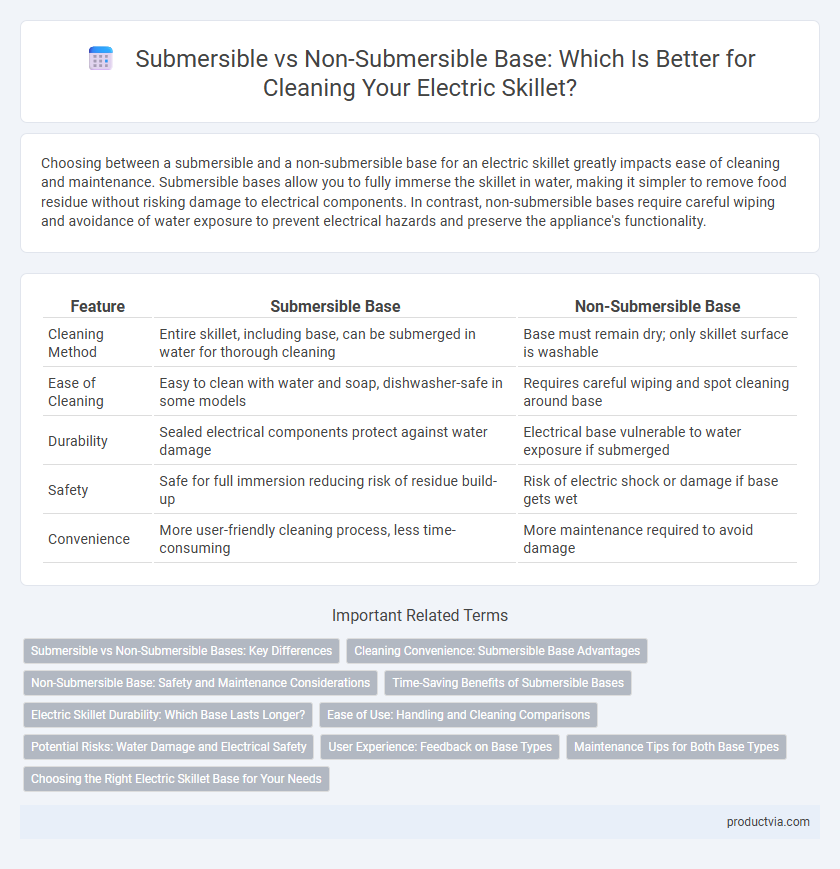Choosing between a submersible and a non-submersible base for an electric skillet greatly impacts ease of cleaning and maintenance. Submersible bases allow you to fully immerse the skillet in water, making it simpler to remove food residue without risking damage to electrical components. In contrast, non-submersible bases require careful wiping and avoidance of water exposure to prevent electrical hazards and preserve the appliance's functionality.
Table of Comparison
| Feature | Submersible Base | Non-Submersible Base |
|---|---|---|
| Cleaning Method | Entire skillet, including base, can be submerged in water for thorough cleaning | Base must remain dry; only skillet surface is washable |
| Ease of Cleaning | Easy to clean with water and soap, dishwasher-safe in some models | Requires careful wiping and spot cleaning around base |
| Durability | Sealed electrical components protect against water damage | Electrical base vulnerable to water exposure if submerged |
| Safety | Safe for full immersion reducing risk of residue build-up | Risk of electric shock or damage if base gets wet |
| Convenience | More user-friendly cleaning process, less time-consuming | More maintenance required to avoid damage |
Submersible vs Non-Submersible Bases: Key Differences
Submersible base electric skillets allow the entire unit, including the base, to be safely immersed in water for thorough cleaning, making them easier to maintain and more hygienic. Non-submersible base skillets require careful detachment of the heating element before cleaning, as the base cannot be immersed, which can make maintenance more time-consuming and less convenient. Choosing between submersible and non-submersible bases affects cleaning efficiency, safety, and long-term durability of the electric skillet.
Cleaning Convenience: Submersible Base Advantages
Electric skillets with submersible bases offer superior cleaning convenience by allowing the entire unit to be safely immersed in water, eliminating the need to wipe around electrical components. This design simplifies maintenance, reduces residue buildup, and extends the appliance's lifespan. In contrast, non-submersible bases require careful spot cleaning to avoid water damage, making the process more time-consuming and less thorough.
Non-Submersible Base: Safety and Maintenance Considerations
A non-submersible base in electric skillets enhances safety by preventing water from entering electrical components, reducing the risk of electric shock or damage. Maintenance involves wiping the base with a damp cloth and avoiding immersion to preserve the integrity of wiring and heating elements. This design requires cautious cleaning methods to ensure longevity while maintaining optimal performance.
Time-Saving Benefits of Submersible Bases
Submersible base electric skillets offer significant time-saving benefits during cleaning by allowing the entire unit, including the base, to be safely immersed in water, streamlining the washing process. This feature eliminates the need to carefully scrub around electrical components, reducing overall cleaning time and effort. In contrast, non-submersible bases require meticulous hand washing to avoid water damage, making cleaning more labor-intensive and longer.
Electric Skillet Durability: Which Base Lasts Longer?
Electric skillets with non-submersible bases often have longer durability because their electrical components remain protected from water damage during cleaning, reducing the risk of corrosion and malfunction. Submersible bases allow for easier cleaning by immersing the entire unit, but repeated exposure to water can degrade the internal wiring and connectors over time. Choosing a non-submersible base typically results in a more robust and longer-lasting electric skillet, especially when cleaned carefully with a damp cloth.
Ease of Use: Handling and Cleaning Comparisons
A submersible base electric skillet offers superior ease of use by allowing the entire unit, including the heating element, to be safely immersed in water for thorough cleaning. In contrast, a non-submersible base requires careful handling to avoid water damage, making cleaning more time-consuming and less convenient. Consumers seeking low-maintenance kitchen appliances often prefer submersible base skillets due to their hassle-free handling and efficient cleaning process.
Potential Risks: Water Damage and Electrical Safety
Choosing between a submersible base and a non-submersible base for electric skillet cleaning hinges on the potential risks of water damage and electrical safety. Submersible bases allow full immersion in water, reducing residue buildup but increasing the risk of internal component corrosion and electrical short circuits if not properly sealed. Non-submersible bases require careful surface cleaning to avoid moisture intrusion, minimizing electrical hazards but necessitating thorough drying to prevent heat damage and ensure safe operation.
User Experience: Feedback on Base Types
Users report that electric skillets with submersible bases offer easier and more thorough cleaning, as the entire unit can be safely immersed in water without damage. Non-submersible base skillets require careful wiping and spot cleaning around the base, which can trap grease and food particles, often leading to less satisfactory hygiene. Reviews commonly highlight the convenience and reduced effort associated with submersible base skillets, enhancing overall user satisfaction in maintenance tasks.
Maintenance Tips for Both Base Types
Electric skillets with submersible bases offer easier cleaning by allowing the entire unit to be safely immersed in water, reducing residue buildup and food debris. Non-submersible base skillets require careful cleaning by wiping the heating element and ensuring no water enters the electrical components, preserving the longevity of the appliance. Maintaining regular cleaning routines and using mild detergents for both types prevents corrosion and electrical damage, ensuring optimal performance and safety.
Choosing the Right Electric Skillet Base for Your Needs
Selecting the right electric skillet base is crucial for efficient cleaning and maintenance; submersible bases offer the advantage of being fully immersible in water, allowing easy and thorough cleaning without damaging electrical components. Non-submersible bases require careful surface wiping and caution to avoid moisture near electrical parts, making them less convenient but often more durable. Understanding these differences helps users balance cleaning ease with appliance longevity based on their specific kitchen habits.
Submersible base vs Non-submersible base for electric skillet cleaning Infographic

 productvia.com
productvia.com